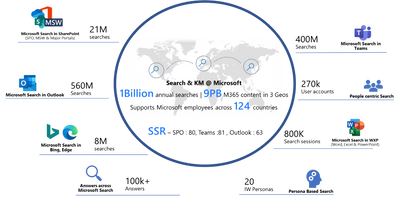
by Contributed | Oct 18, 2022 | Technology
This article is contributed. See the original author and article here.
The Challenge
Five years ago employee satisfaction with finding information within the company was very low. it was the lowest rated it service among all those we surveyed about. Related surveys done by other teams supported this, for instance that our software engineers “finding information” as one of the most wasteful frustrating activities in their job, costing the company thousands of man years of productivity.
A project team was formed to improve this. In the years since we have pursued:
- Improving search result relevance
- Improving search content completeness
- Address content quality issues
The Microsoft Search Environment
Microsoft has >300,000 employees working around the globe, and collectively, our employees use or access many petabytes of content as they move through their workday. within our employee base, there are many different personas who have widely varying search interests and use hundreds of content sources. Those content sources can be file shares, Microsoft sharepoint sites, documents and other files, and internal websites. our employees also frequently access external websites, such as hr partners’ websites.

We began with user satisfaction survey net score at 87 (scale of 1-200, with 200 being perfect). We have reached satisfaction of 117. Our goal is 130+.
What We’ve Done
Core to our progress has been:
- Understanding the needs of the different personas around the company. At Microsoft, personas are commonly clustered based on three factors: their organization within the company, their profession, and their geographic location. For example, a Microsoft seller working in Latin America has different search interests than an engineer working in China.
- Has resulted in targeting bookmarks to certain security groups.
- Has led to outreach to certain groups and connecting with efforts they had underway to build a custom search portal or improve content discoverability.
- Understanding typical search behavior. For instance, the diagram below shows that a relatively small number of search terms account for a large portion of the search activity.

- We ensure bookmarks exist for most of the high frequency searches.
- We look for commonalities in low frequency searches for potential content to connect in.
- Improving content quality. This has ranged from deleting old content to educating content owners on most effective ways to adding metadata to their content so it ranks better in search results. As part of our partnership with this community, we provide reporting on measurable aspects of content quality. We are in early stages of pursuing quality improvement, with much to do in building a community across the company, measuring, and enabling metadata.
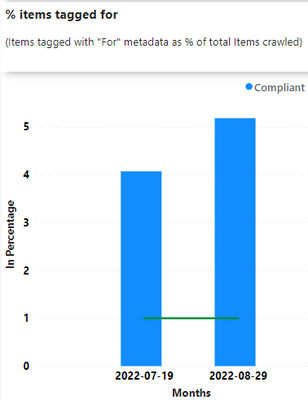
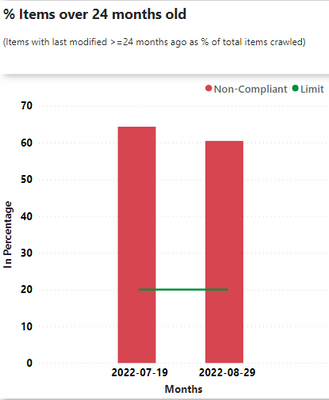
- For those site owners actively using this reporting, we have seen a decrease of up to 70% in content with no recent updates.
- Utilizing improvements delivered in product, from improved relevance ranking to UX options like custom filters.
- We have seen steady improvement in result ranking.
- We also take advantage of custom filters and custom result KQL.
- We use Viva Topics. Topics now receive the most clicks after Bookmarks.
- Making our search coverage more complete. Whether it’s via bookmarks or connectors, there are many ways of making the search experience feel like it covers the entire company.
- We currently have 7 connections, one of which is custom built and brings in 10 different content sources. This content is clicked on in 5% of searches on our corporate SharePoint portal.
- About half of our bookmarks (~600) point to URLs outside of the corporate boundary, such as third-party hosted services.
- Analytics. Using SharePoint extensions, we capture all search terms and click actions on our corporate portal’s search page. We’ve used these extensively in deciding what actions to take. The sample below is a report on bookmarks and their usage. This chart alone enabled us to remove 30% of our bookmarks due to lack of use.

In analyzing the click activity on our corporate portal, the most impactful elements are:
Bookmarks
|
Are clicked on in 45% of all searches and significantly shortens the duration of a search session.
We currently have ~1200 bookmarks making for quick discovery of the most commonly searched for content and tools around the company.
|
Topics
|
Are clicked on in 5-7% of all searches.
|
Connectors
|
Are clicked on in 4-5% of all searches.
|
Metadata
|
Good metadata typically moves an item from the bottom of the first page to the top half and from page 2 or later onto the bottom of page 1.
|
Additional details will be published in later blog posts. If of interest, details as to exactly what Microsoft search admin does in its regular administrative activities are described here.
Business Impact of Search
As shown in the preceding table, roughly half of all enterprise-level searches benefit from one of the search admin capabilities. Employees who receive such benefits average a one-minute faster search completion time than those whose searches don’t use those capabilities. Across 1.2 million monthly enterprise-level searches at Microsoft, that time savings amounts to more than 8,000 hours a month of direct employee-productivity benefit.
We achieve these results with an admin team of part-time individuals, investing a total of <300 hours per month doing direct search administration, responding to user requests to help find individual items, and maintaining a self-help site which advises employees on where and how to search best. We also have a larger improvement program striving to improve information discoverability across the company.
So 5 years into our improvement efforts, we have significantly improved user satisfaction, can now measure the productivity impact search is having, and built numerous partnerships across the company that are expected to continue yielding improvements in the years to come.
Lessons from this work is actively improving search has significant payback. The first step is to actively administer search, doing whatever helps the most popular searches to deliver the right results.
by Scott Muniz | Oct 18, 2022 | Security, Technology
This article is contributed. See the original author and article here.
CISA released two Industrial Control Systems (ICS) advisories on October 18, 2022. These advisories provide timely information about current security issues, vulnerabilities, and exploits surrounding ICS.
CISA encourages users and administrators to review the newly released ICS advisories for technical details and mitigations:

by Contributed | Oct 17, 2022 | Technology
This article is contributed. See the original author and article here.

Overview
Backup and restore are key pillars for business continuity and disaster recovery offerings for Azure Database for PostgreSQL Flexible Server. We’re excited to announce new features including Fast Restore, Geo Restore and Custom Restore Points to allow you more fine-grained control on your DR plan to achieve the RPO^ and RTO^^ objectives. In this post we’ll share an overview of each of these new features. Let’s get started.
1. Fast Restore
Point-in-time restore (PITR) is critical for disaster recovery by allowing recovery from accidental database deletion and data corruption scenarios. Today, PostgreSQL Flexible server performs automatic snapshot backups and allows restoring to latest point or a custom restore point. The estimated time to recover is heavily dependent on the size of transactions logs (WAL) that need to be replayed at the time of recovery. Without having much visibility into the last full backup time, it was never easy to predict the amount of time it takes to restore.
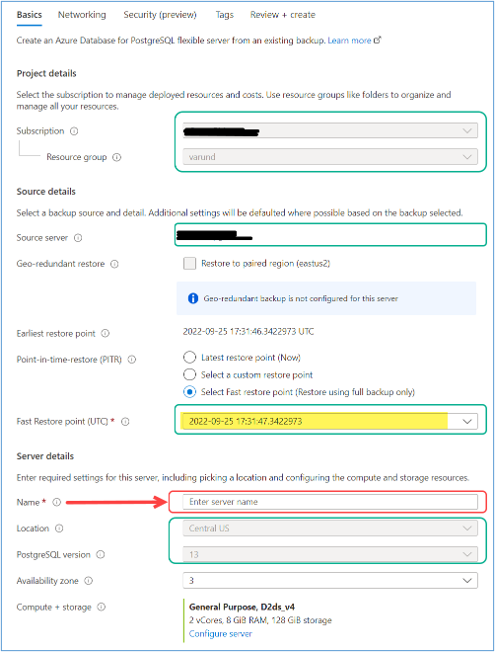
Many enterprises have use cases like testing, development, and data verifications where they don’t always require the latest data but need the ability to spin up a server quickly to ensure business continuity, we are glad to announce that Azure Database for PostgreSQL – Flexible Server now supports the Fast Restore feature to address these use cases. This lists all the available backups that you can choose to restore. Restore with provisions a new server and restores the backup from the snapshot and as no transaction log recovery is involved, the restores are fast and predictable.
For more details about Fast Restore, refer the how-to-guide.
2. Geo Backups and Restore
Organizations around the world, such as government agencies, financial institutions, and healthcare providers, are looking for ways to protect their valuable data from regional failures including natural disasters. Azure Database for PostgreSQL Flexible Server already provides high availability (HA) using same zone and cross zone redundancy options. However, it cannot protect from all possible data loss scenarios such as a malicious actor, or logical corruption of a database.
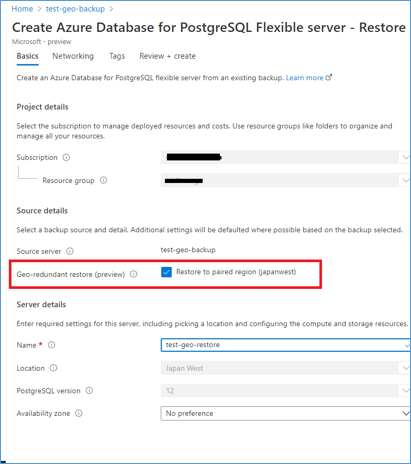
For added disaster recovery capability, Flexible server now offers Geo Backups and Restore. This feature allows you configure your Azure postgres database to replicate snapshots and transaction logs to a paired region asynchronously through storage replication. Geo redundant backups can be restored to the server in paired region.
For more information about performing a geo-restore, refer the how-to guide.
3. Backups and Restore blade
We have heard your feedback for having better visibility into the backup and added a dedicated Backup and Restore blade in the Azure portal. This blade lists the backups available within the server’s retention period, effectively providing customers with single pane view for managing a server’s backups and consequent restores.
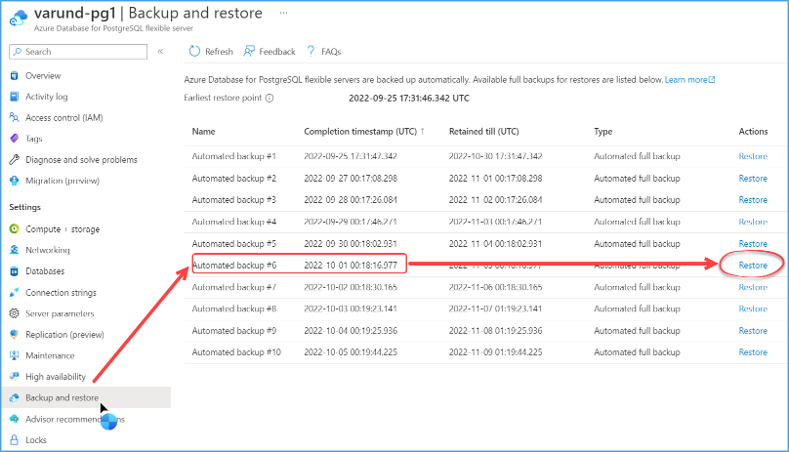
Customers can use this for the following:
- View the completion timestamps for all available full backups within the server’s retention period
- Perform restore operations using these full backups.
The list of available backups includes all full automated backups within the retention period, a timestamp showing the successful completion, a timestamp indicating how long a backup will be retained, and a restore action.
Conclusion
In this post, we shared some key backup and restore enhancements to provide disaster recovery within Azure database for PostgreSQL Flexible Server. Geo-backups are ideal if you need a cost-effective cross-Region DR capability that helps save on compute costs. Fast restore allows to have more predictable restore time. And backup restore blade exposing the history of full backups.
If you have any feedback for us or questions, drop us an email @AskAzureDBforPostgreSQL.
With these improvements, we continue to innovate the service offering and backup and restore capabilities of Azure Database for PostgreSQL Flexible Server.
^ RTO is Recovery Time Objective and is a measure of how quickly after an outage an application must be available again.
^^ RPO is Recovery Point Objective, refers to how much data loss an application can tolerate.
Acknowledgements
Special thanks to Kanchan Bharati for co-authoring this post.
by Contributed | Oct 16, 2022 | Technology
This article is contributed. See the original author and article here.
We had the great honor of being able to talk about the lessons learned from the Azure Database Support Blog Series in Data Exposed about the work done for all Azure SQL Database Support Team.
A huge thanks to Anna Hoffman and all her team from for giving us this opportunity.
In this episode of Data Exposed, Anna Hoffman and myself show Azure Database Support blog series where you can find the most common issues faced by Azure SQL customers and how Microsoft Support Engineers fixed them.
Enjoy!
by Contributed | Oct 14, 2022 | Technology
This article is contributed. See the original author and article here.
Microsoft and Rogers Business are bringing new levels of mobility and flexibility to Microsoft Teams customers in Canada. Rogers Business was the first Canadian carrier to implement Microsoft Direct Routing and the first to offer Operator Connect. Now, as the first partner to implement Teams Phone Mobile, Rogers Business extends the strength and quality of their mobile network to organizations that support the needs of mobile and hybrid workers.
With Teams Phone Mobile, customers can assign a single, business-provided number for calling to and from the user’s mobile phone and all their Teams endpoints. With Teams Phone Mobile, your users stay connected and productive, wherever work takes them.
Mahendra Sekaran, Vice President of Microsoft Teams Engineering and Tom Turner, President of Rogers Business recently sat down to discuss this partnership and the significant investments in mobile-first solutions designed to make it easy for customers to get the best in connectivity, voice services, and productivity applications, all in one place.https://www.microsoft.com/en-us/videoplayer/embed/RE59Jrr?autoplay=false
Watch the video to hear more about the benefits this partnership brings to our Canadian customers.
“What we’re focused on is providing an incredible customer experience by integrating our wire line services, our wireless services, and those core applications customers need. The Microsoft partnership is absolutely key and a cornerstone to that. So much so that we’ve integrated our network and the Microsoft services into a single platform, which creates a unique value for our customers”.
– Tom Turner, President of Rogers Business
Learn more about Teams Phone Mobile which allows you to provide cellular network quality of service to Teams communications, while allowing customers to enforce business policies, reduce costs, and improve the user experience for the growing mobile workforce.



Recent Comments